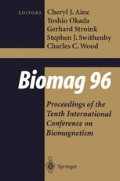Abstract
In the EEG / MEG inverse problem solving, it appears that most of the time single dipole models fail to produce acceptable results — specially with the late components of evoked potentials — when space and time overlapping in the source pattern is very likely. At the same time, minimum-norm multi-source solutions exhibit over-smoothed magnitude patterns and, unless specified, do not respect brain anatomical constraints like sulcus borders. Moreover, these methods fail to recover deeper sources because dipoles located at the surface of the source space (the cortex surface, basically) would be privileged for the same data set. Recently Pascual-Marqui et al. have presented a generalized minimum-norm Solution to the inverse problem that appears to overcome some of these limitations but still offers smoothed dipole images [1].
Access this chapter
Tax calculation will be finalised at checkout
Purchases are for personal use only
Preview
Unable to display preview. Download preview PDF.
References
Pascual-Marqui, R.D., et al., Low resolution electromagnetic tomography: a new method for localizing electrical activity of the brain, Int. Journal of Psychophysiology, 1994, 18:49–65.
Baillet, S., and Garnero, L., A Bayesian approach to introducing anatomo-functional priors in the EEG/MEG inverse problem, submitted to IEEE Trans, on Biomed. Eng., february 1996.
Dale, A.M., and Sereno, A.M., Improved localization of cortical activity by combining EEG and MEG with MRI cortical surface reconstruction: a linear approach, J. Cogni. Neurosci., 1993, 5: 162–176.
Tzourio, N., et al., Mapping the auditory selective attention generators using a combined brain evoked potentials and PET activation study, Society for the Neuroscience Abstracts, 1993, 19: 1285.
Geman, S., and MacClure, D.E., Statistical methods for tomographic image reconstruction, Inverse Problems, 1987, 21: 5–21.
Gindi G., et al., Bayesian reconstruction of functionnal images using anatomical informaton as priors, IEEE Trans. Med. Imaging, 1993, 12: 670–680.
Author information
Authors and Affiliations
Editor information
Editors and Affiliations
Rights and permissions
Copyright information
© 2000 Springer Science+Business Media New York
About this paper
Cite this paper
Baillet, S., Garnero, L., Renault, B. (2000). Distributed Source Reconstruction Using a Non-Linear Spatio-Temporal Regularization Method: An Alternative to LORETA. In: Aine, C.J., Stroink, G., Wood, C.C., Okada, Y., Swithenby, S.J. (eds) Biomag 96. Springer, New York, NY. https://doi.org/10.1007/978-1-4612-1260-7_42
Download citation
DOI: https://doi.org/10.1007/978-1-4612-1260-7_42
Publisher Name: Springer, New York, NY
Print ISBN: 978-1-4612-7066-9
Online ISBN: 978-1-4612-1260-7
eBook Packages: Springer Book Archive

